|
FAQs on Catfish
Identification
Related Articles: Catfishes, Sucker mouth Cats/Loricariids,
Otocinclus, Callichthyids, Ictalurid Catfishes, Mochokids/Synodontis, Candirus (Trichomycterids, Cetopsids),
Marine Catfishes: Plotosids,
Ariids,
Related Catfish FAQs: General, Behavior, Compatibility, Selection, Systems, Feeding, Disease, Reproduction,
Synodontis
multipunctatus
|
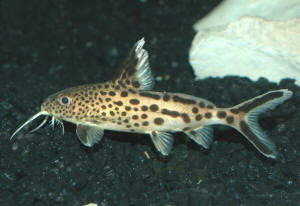
|
|
Help with fish ID please 5/4/19
Greetings WWM crew,
<Howsit?>
My LFS just got in a group of cool-looking cats that they labeled as ‘spotted
catfish’ but, so far as I can tell, it’s a descriptive rather than an actual
name. Any idea what these fellows are? They are currently about 6-8 inches long
and about 1-1.5 inches in diameter.
<What the?! This looks like the olde Albino Walking Catfish (to me); Clarias
batrachus>
Thanks in advance for your help!
Cheers,
Linda
<I thought was still illegal nationally... in the USA. Invasive and hard to
eradicate. Bob Fenner>
|
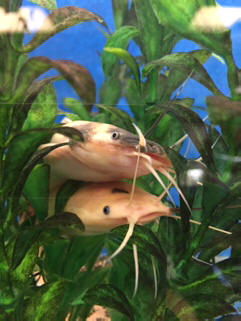
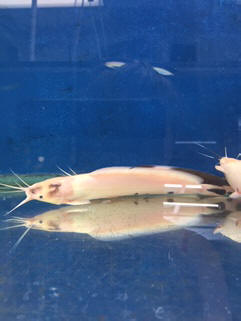 |
|
Re: Help with fish ID please 5/4/19
Hi Bob,
<Linda>
I KNEW they looked familiar! We used to get these suckers flopping down the
street down in Florida whenever we had heavy rains. Yikes!
<EEyeah!>
They sure are cute (at their current small size) but I don’t want a 1-m-long
Hoover in my tank, even if they WEREN’T illegal!
Thanks for the swift reply!
Linda
<Thanks for sending in the pix of the plu duc dam... I think this is the olde
Thai name. BobF>
|
|
Mystery Cat Fish 12/24/18
About 6 months a go I bought 3 bumblebee catfish. At the shop there was one of
the catfish that stood out it was browner, longer, thinner and had different
fins but as were so young it easily looked like a bumblebee catfish and the
people at the shop thought it was so I decided to get the odd ball. However now
I have recently been observing it every night and have noticed it is not a
bumblebee catfish but am unable to find on the internet any matches. Photoing it
was very difficult as hides a lot and the dark colours. These are the photos I
got, If you have any idea what this is it would be much appreciated as would
like to make sure has correct care. The photo doesn’t show but it’s barbels have
smaller barbels branching off of them
Thank you
From Josh
<Josh, this appears to be some sort of Synodontis, though the photos are, as you
say, not quite bright and sharp enough to be sure. Armoured head, smooth body,
long adipose fin, and long bristly whiskers would seem to point to this genus.
But which species? Ah! That's more difficult. Do try here for a start:
https://www.planetcatfish.com/common/genus.php?genus_id=29
Most Synodontis get to around 15 cm in length and tend to be harmless loners;
territorial towards their own kind, under aquarium conditions at least. They can
be predatory towards very small fish, but are primarily omnivores consuming
algae wafers, cooked peas, bloodworms, minced seafood, and all the usual catfish
pellets. They are usually very hardy and adaptable, but the relatively slender
body shape of yours suggests a rheophilic or at least riverine species, so I'd
be sensitive to the fact this species may want strong currents and high oxygen
levels. Beyond that though, they're usually bullet-proof. Cheers, Neale.>
|
.jpeg) |
|
Re: Mystery Cat Fish 12/24/18
Thank you very much and thank you for the care help
<Most welcome.>
Have a good Christmas
<You too!>
From Josh
<Cheers, Neale.>
|
Unknown catfish 6/11/12
Hello crew! I recently bought a tank off my cousin that was small and
neglected in hopes to save his fish from hardships.
<Nice of you to help out.>
He had 6 fish that i temporarily added to my own tank in hopes of
cleaning the ten gallon that i got. My 15 gallon, pristine and
exceptionally cared for is housed to my dearest black blotch cichlid who
usually lives alone and tends to be an aggressive male.
<Not really sure what a "black blotch cichlid" might be. Do you mean
Vieja maculicauda, the Black Belt Cichlid? A large, almost entirely
herbivorous species.>
I plan on getting a 50 gallon soon for my best friend who is said to
grow a foot?
<Vieja maculicauda can certainly get to almost that size, though 20-25
cm/8-10 inches is more typical.>
Well I've had this guy for a while and while he is only six inches he
managed to eat a couple of the fish i got while i wasn't looking.
<Are you feeding him enough green foods? They are almost 100% herbivores
in the wild, and unless you give enough greens, obviously it won't grow
or do well. It also needs an adequately large tank, and if kept in a 15
gallon tank, then chances are you may have stunted the fish, unless you
did very frequent water (daily!) changes.>
He ate a Danio and a tetra of some sort.
<Not good.>
Now the other two Danios are a little tattered too. They weren't doing
too well when i first got them but are fine now. The other two fish are
cats, my misguided cousin didn't have adequate tanks and knowledge, and
had given me a Chinese that was 8 inches which i
brought to my local pet store in hopes of finding him a better home.
<What's a "Chinese"? Do you mean the so-called Chinese Algae Eater,
Gyrinocheilus aymonieri, a fish that doesn't come from China and doesn't
eat much algae.>
So the biggest question here is for species suggestions for this other
cat. This cat is very small, about six inches and is dominantly
orange with a few black splatters about him.
<Is this the golden morph of Gyrinocheilus aymonieri? They're
about the commonest golden fish that might be mistaken for a catfish
(they're not catfish or even loaches, but their own special kind of
bottom-dwelling fish). Other options include albino Corydoras (often
Corydoras paleatus), albino Ancistrus ("Bristlenose Catfish"), and
albino Plecs (Pterygoplichthys species).>
This fish has the typical wide mouth and barbells, and though it hides
all the time with my cichlid who doesn't see him as food i could tell
that this cat has a typical slender shape down to the tail. I cannot
identify him as i cant catch more than a glance of his side while he
hides. I can honestly say that i don't expect my new Danios to last long
being that my parents will not allow me to set up this new tank now that
I've cleaned it. My cichlid is bound to eat them too.
<Likely, especially if hungry/not given enough greens.>
So the cichlid and the cat both should grow rather large but i plan on a
larger tank to house them both. Another question is how to treat the cat
so that he is more trusting. I managed to get my cichlid over time to
stop hiding and be friendly when he isn't mad that i cleaned the tank
and got gravel in his home! Any suggestions?
<If these "cats" are both Gyrinocheilus aymonieri, they are extremely
territorial and WILL NOT get along in one tank.>
Also i have a smaller version of a bio filter i already use from my
cousin. I took the old carbon out and plan on using it just as another
bio. My cichlid isn't bothered by a lot
<…a lot…>
of movement in my tank but would the catfish like calmer waters too?
Thanks a lot! _matt
<Welcome, Neale.>
re: Unknown catfish 6/11/12
Your right about the cichlid, and i will be giving him a better tank. I
will construct a better diet as soon as i get off work today. He was
rather large when i got him a month ago so i am not worried about
stunting as you cant stunt something that is already grown.
<Quite so. Fish grow throughout their lives, but once they get above a
certain age -- usually within a year for cichlids -- that growth rate
slows right down to almost imperceptible amounts. So while your fish may
grow a little more, especially if moved to a much bigger tank, it's
unlikely he'll ever reach the maximum size for this species.>
However i will make she he is not cramped. The Chinese i spoke
about is the exact fish you mentioned. I knew that it would be
to much which is why i brought it to a dealer right away. As for the
other fish ill look at info for the suggested species and see if it all
adds up. Thank you so much -
matt
<Glad to help. Cheers, Neale.>
|
It's Just a Catfish! Not... 3/22/10
Hi Bob & Crew,
Any truth to this?
James
<No, it's a Whale Shark, Rhincodon typus. The white spots
and the longitudinal furrows on the back are very distinctive.
There are some gigantic catfish in Asia, including at last one
Pangasius species that (unknown to anyone until recently) spends
part of its life cycle at sea. But this isn't one of them!
I'm not sure if Whale Sharks are cannibalistic; to the best
of my knowledge, and Bob may know better, they feed exclusively
on zooplankton, squid and small schooling fish. In other words,
much like the baleen whales they are so clearly convergent with.
Cheers, Neale.>
>>It's Just a Catfish! Yeah, sure!!
>>For all those crazy guys who go 'noodling' for
catfish and stick their
arms down the fish's throat!! This would be 'all the
catfish you can eat',
>>Each year, a few people were drowning or disappearing
mysteriously in
Huadu's Furong (China) Reservoir. It was not until recently,
when the son
of a government official went swimming, in the reservoir and was
drowned,
that the secret was revealed.
>>It is a 3 meter (9.8ft) long man-eating catfish whose
head alone is 1
meter (3.3ft) wide!
>>After cutting up the catfish, people were surprised to
find the remains
of another man inside!
>>Swimming in the reservoir is now forbidden because it is
feared another
similar man-eating catfish is still lurking in the waters.
>>It's Just a Catfish!
|
 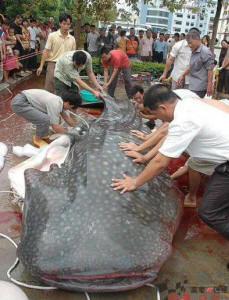 |
Re: It's Just a Catfish!
3/22/10
Didn't think so. Thanks Neale.
James
<Most welcome! Cheers, Neale.> |
|
Chrysichthys spp. 1/19/10
Hi.
I bought a catfish yesterday labeled as an aluminum catfish.
<Crikey! Haven't seen one of these in the trade for YEARS!
Used to be semi-commonly traded here in the UK during the 1980s,
when big catfish were very much the "in thing". Now
hardly ever seen.>
I was under the impression that the "aluminum catfish"
was a single species of fish that reached an adult size of about
8 inches. I was wrong.... When I got home, I did some research,
only to find that almost all of the fish in the Chrysichthys
genus reached sizes of over 12" in length.
<Indeed, several species sold as Aluminium Catfishes,
including some Chrysichthys species, but also Clarotes laticeps,
and possibly others. When at university I was sold an
"Aluminium Catfish" that turned out to be nothing more
than a Channel Catfish, Ictalurus. The Ali Cat name really gets
applied to most any big, silvery (usually African) catfish. So
you have to be careful. Yours certainly isn't an Ictalurus,
and it isn't the Chrysichthys species I used to keep,
Chrysichthys ornatus. It does look a lot like Chrysichthys
longipinnis, what Fishbase calls the Aluminium Catfish. That
species supposedly reaches a maximum length of 70 cm (27 inches),
and even assuming it only gets about 2/3rds that size (often the
case with riverine cats) you're still looking at some thing
around 45 cm in length (about 18 inches).>
Some only got to 13" or so, but others topped 2'. Is
there any way that I can i.d. my cat so I know how large it will
get?
<As juveniles, many clarotid catfish look exceedingly similar,
so it's impossible to say for sure. I think this is
Chrysichthys longipinnis, though adults of that species have
quite well developed dorsal fins. Do also look at Chrysichthys
nigrodigitatus, another species that is occasionally traded. In
short, review Fishbase, in particular the thumbnails of species
in the family Claroteidae.
http://filaman.ifm-geomar.de/identification/specieslist.cfm?famcode=668&area
code=
>
If you can provide any insight, that would be great. I think I
have Chrysichthys auratus, but my fish is only a juvenile, about
1.5", so it's hard for me to tell.
<Quite so; Chrysichthys auratus should have an obviously
golden colour, which this specimen appears to lack.>
I have attached some photos of it; sorry for the poor quality and
the smudges on the glass. Semester exams are coming up and I
haven't had time to clean my aquarium's glass.
Thanks in advance!
<I kept Chrysichthys ornatus for a long time, 10 years, before
passing him on to another aquarist with some similarly venerable
Ctenopoma and Synodontis. In short, my experience of Chrysichthys
ornatus was that this was a very hardy, essentially peaceful, but
extremely predatory animal capable of swallowing tankmates up to
2/3rds it size (lost a blue Gourami that way). So DO NOT
underestimate the "bite" of these animals. They are top
predators, and need to be treated as such. Typical riverine
fish:
unfussy about water chemistry, but appreciate water current and
good oxygenation. Eat anything; earthworms, krill, chopped fish
fillet as well as catfish pellets will all work well for its
diet. A superb fish, but you WILL need a big tank for him.
Cheers, Neale.>
|
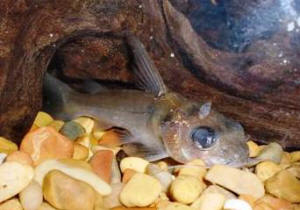 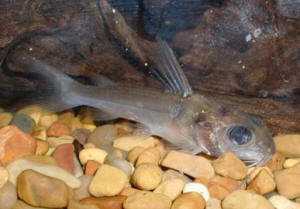 |
|
Re: Chrysichthys spp.
1/20/10
Thanks for your reply Neale.
<Pleasure.>
I looked through Fishbase and talked with the folks on
planetcatfish.com....
<A good site.>
It seems that only time will tell what species I have, but what
do you think the chances are that I have a species that will
reach a size of under 12"/30cm in captivity?
<Unknown, but honestly, I doubt you'll be that
lucky.>
The guys on planetcatfish mentioned C. polli,
<Not traded, so far as I know. If it's so uncommonly seen
Fishbase doesn't have a photo of the live fish, it's
pretty unlikely to turn up in a pet store.>
and I have been looking at a couple pictures of C.
brevibarbis...
<Perhaps.>
both of these seem to match my fish, at least more closely than
C. longipinnis.
<This is the Ali Cat of the trade though.>
Or should I say, I hope that those species match my cat more
closely than C. longipinnis?
<Comparing a photo of a pickled fish at Fishbase to a live one
is practically pointless, so I really can't comment on
Chrysichthys polli. I've never seen a live specimen.>
As you can probably tell, I really want to keep this fish...
<By all means keep it. Even if it's a small species,
it's going to be around 30-45 cm when mature, and that's
a fish that needs a big tank and robust tankmates. Hope for the
best, but plan for the worst. Cheers, Neale.>
|
Unidentified Catfish, Catfish ID - 06/27/07 Hi,
I've been searching sites (Thanks Google) for a while now looking
for anything to help identify a recently adopted catfish. So far, your
site seems to be the most informative and popular, so here I am. The
new guy (or girl) is approximately 6-7 inches long with barbels
extending about the same distance. The general shape is that of a
Pictus sp. as far as I can tell. It appears to be "naked"
with a light silver body, white belly and 3 poorly defined lateral
stripes of black, white and black. The tail fin is forked. I know it
would be easier to identify with a picture, but I can't provide one
yet. As far as behavior goes: It hides under my rock formation and
comes out only at night. When he does come out, he taps the front of
the tank as if maybe the glass will give way. I've had him about a
week and have yet to see him eat anything. A few freeze dried krill
have disappeared after a while in the tank, but since they float I
can't be sure it was the catfish that ate them. Other then that
I've tried shrimp pellets and "variety wafers" since they
sink nicely. I know some catfish eat the wrong things sometimes when
they get hungry and I want to make sure my other fish will be ok. I
have a 55 Gal. with 2 Blue Gouramis, 2 Neon Blue Dwarf Gouramis, 2
Clown Loaches, 5 Platies and 3 Julii Corys. (and the 6 inch cat) Thank
you for any help you can provide. Josh < Of coarse a picture would
be very helpful, so instead check out planetcatfish.com. Check for one
of the Mystus cat or Pimelodus species.-Chuck>
Yellow eel tail catfish 6/5/07 Do you have any
information on this freshwater aquarium sized fish. it is Australian i
have been told. < Indeed it is Australasian. The yellow-tail eel
catfish is a species of Plotosidae, that is, a catfish belonging to the
same group as the marine striped catfish that used to be quite common
in the trade. The exact species is unknown to me. The name is not
recognized by Fishbase or any aquarium book I have, and is only used by
a single fish farm's web site and they don't even mention the
Latin name! It may possibly be Neosilurus hyrtlii or Neosilurus
glencoensis, both of which have been traded as the yellow-finned eel
catfish. Anyway, these catfish are all pretty similar, and while there
are some dwarf species (15 cm or less) and some giant species (above 90
cm), most are 25-50 cm size bracket. The freshwater species outnumber
the marine species, and in terms of water chemistry these freshwater
species are not in the least fussy and will adapt to anything suitable
for freshwater fish generally.> > put one in my cichlid tank and
lost all of my cichlids. they died one after the other. do you think it
would be disease or something to do with the catfish ??? i have kept
these cichlids for approx. 4 years with no previous problems. <Well,
these catfish are extremely capable predators, and can and will eat
anything they can stuff into their mouths. But they are also venomous,
being equipped with one or more spines capable of delivering an
excruciatingly painful venom. To be fair though, venomous fish rarely
if ever use their venoms offensively, so the catfish wouldn't
deliberately jam itself against a cichlid intending to kill the
cichlid. But depending on the size difference, I suppose it's
possible the cichlids tried to eat the catfish, and got stung that way.
Regardless, the Plotosidae generally make acceptable tankmates for
robust communities. The Plotosidae tend to be more or less gregarious,
and at least when not fully grown seem to do best kept in groups. Some
species will in fact pine away completely if not kept with companions.
As they mature they become less sociable and expect secure hidey-holes,
but even adults tend to be found in twos and threes in the wild, so
getting a buddy or two for your catfish is probably a very good idea.
Hope this helps, Neale>
Re: yellow eel tail catfish 6/6/07
thanks...for prompt reply.... <No problem.> do you think the
catfish has brought in a virus or disease that killed off the rest of
my tank as the catfish is the only survivor now. lost rainbow sharks,
cichlids and small catfish x2 all dead except the newly arrived catfish
<Seems very unlikely. Viruses tend to be species-specific. Possibly
a bacteria, but these tend to affect only certain fish and even in
worst-case scenarios the fish get ill gradually and obviously. So
you'd notice things like lethargy, loss of colour, dropsy, and so
on before fish infected with internal bacteria or parasites actually
died. Some fish have a toxic mucous (boxfish for example) but these
tend to kill everything, including the boxfish. So I don't think
that's likely. If the catfish was simply attacking things at night,
you'd expect to see damage on the dead fish -- any sign of that? If
you had an electric catfish, explaining the sudden deaths would be
easier, too. But assuming you have a genuine eel-tail catfish of some
type that's not a possibility either. Obviously you need to check
water quality and chemistry. This may be a case of two unrelated events
merely connected in time: i.e., you introduced the catfish at the same
time your aquarium crashed for one reason or another.> regards tom
<A picture of the catfish, and some aquarium stats would be useful:
size of the tank, filtration, pH, hardness, nitrite. Cheers,
Neale>
Butterfly Catfish, Identification - 07/25/2006
<Sisoridae> Hello Bob my name is Allan Larkins I am the
general manager of creatures great and small in Victoria I have seen
several postings for people trying to research butterfly catfish and
unfortunately the answer is always the same "did you mean African
butterfly fish" but the fish they are trying to research is also
known as the Asian moth cat Latin: HARA HARA OR HARA JORDANI.
<Hmm.... I'm thinking you might mean Hara jerdoni, here; seems
that H. jordani may be a common misspelling of this name. Fishbase and
PlanetCatfish both seem to lead in that direction. And thanks for this!
I've never heard this group called "moth" cats.> Look
forward to more great info on your site. <I will. I always do.>
Sincerely, Allan <All the best to you, -Sabrina>
Shades of Billy Shakespeare! Blue Dolphin Catfish?
12/22/2005 I have just purchased what they called a blind brackish
blue dolphin catfish. Is there such a fish, I can not find him any
where. I have him in a nano tank. Can you give me any info or place to
go for info. Thanks, Jane <Mmm, doesn't come up on
Fishbase.org... I suspect this is a nomen for some species of Cetopsid
(whale catfish), or perhaps (my second guess), an Ariid... Can you send
a likeness/pic? Bob Fenner>
Freshwater: Algae Eater. of some sort - 10/24/05
Hello there <Hello.> I have a quick question for you. I have lost
3 algae eaters in the past month. The second one we bought from our
local fish store, it died within a few days. The last one that we just
bought (from a diff. pet store) lasted for a week. Is there a thing
called bad algae that could be killing our poor algae eaters? <This
is where we run into a problem with common names there are various fish
that retailers label as algae eaters. Could be anything from a Chinese
Algae Eater (Gyrinocheilus aymonieri) to a Golden Algae Eater
(Gyrinocheilus aymonieri), heck I have even seen the common Pleco
(Hypostomus punctatus or Liposarcus multiradiatus) labeled as an algae
eater. In short if any of these fish keep passing away on you, there is
something wrong with the environment: your tank. Could be a number of
things from poor water quality (ammonia, nitrites, nitrates,
temperature, improper pH) to improper acclimation procedure. Keep in
mind while these fish do eat algae, all but the largest of tanks cannot
provide adequate algae to keep them healthy. You will have to
supplement with some type of wafer or pellet composed of vegetable
material.> Sorry not to mention this earlier - this is a fresh
water, the water tests fine and its been up for a little over a year.
Thanks for helping. Cody <You're welcome, Adam J.>
ALBINO CATFISH Hello, When I was a kid, my dad
had an aquarium & pet shop. I loved watching the fish, but not
doing the "cleaning & what-not". I still love watching
the fish, but not the cleaning. I have a 20 gal. tank that I think keep
pretty clean. The water is always clear, & most of the fish look
great! The problems I am having are this: I have an Albino Cat Fish in
the tank that is so light colored, it looks almost white. At first, I
thought it looked that way because of the light, but now I don't
think so as the fish was more of a pink color when I got it. My other
cat fish died about a month ago and looked just as white as this one
does. Any suggestions on what I should do? Lisa < Albino fish are
actually pretty common in the hobby. Genetically though they seem
weaker than their normal colored counterparts. If you are worried then
I would check the nitrates. These can creep up over time and cause weak
fish to get sick. Up to 25 ppm is fine for most fish , but in your case
I would try and keep it under 20.-Chuck>
Black fin FW shark I
supposedly have a black fin shark. I have read on a website that it is
called a Tetra Catfish. Is this true? < I can only find them listed
as Black Finned sharks, but common names are often different in
different areas of the country.> I also need a way too sex it. It is
fully black except all around its fins is white, and one or two of its
whiskers is white. (WHISKERS!) < Your catfish (Pangasius pangasius )
gets huge, around 4 feet long. This fish probably is not sexually
mature until it gets at least 2 to 3 feet long.> Also I have a mud
turtle, 5 minnows, and this shark all in a twenty gallon tank, but is
only filled about five inches high in water for the turtle. I plan to
buy more black fin sharks (AKA Tetra Catfish) so I need a way to tell
male from female! Thanks in advance! < Nothing is known about their
sexing or reproductive behavior in the aquarium.-Chuck>
Pleco ID Where can I find out what type of Pleco I have as it
does not seem to match any photos on the net? Can I send you a photo?
<The best site for all info covering Plecos is planetcatfish.com.
I'd be happy to take a look. Don> Thanks Chetna
Ageneiosus marmoratus - "dolphin catfish"? Hi Mr.
Fenner: <Crewmember Sabrina here for yah this afternoon> Hope
everything is going great for you this holiday season. <Indeed it
is, thank you - I hope all is well for you, as well.> I am writing
to see if you can provide some info as to what is a "dolphin
catfish". I did a search online and came up with many links that
said a Dolphin catfish is the same as Pseudodoras niger. <This is
what I have found, as well.> That was a surprise for me but I
figured it could be possible. <Common names for many fish differ
greatly depending upon locality, unfortunately. Latin names are much
more sound.> However, 1 link took me to a website of a Japanese
importer where he has pictures of different "dolphin
catfishes" and they were all members of the family Ageneiosidae.
<This is a genus of the family Auchenipteridae. Might want to make
use of the inexhaustible PlanetCatfish: http://www.planetcatfish.com/core/index.htm
. Check out the "Cat-eLog" - I love this site for catfish
reference.> I have been looking for a specific member of the
Ageneiosidae family for many years with no success but I have been
looking for it under a different name (Marbled Flat-nosed cat or
Marbled slopehead catfish). Is this family of catfish the ones known as
Dolphin Catfishes or is it yet a different fish? <Honestly, I am not
familiar with that common name, other than finding it via Google
searches, etc., and there, like you, I find it in reference to
Pseudodoras niger.> Thank you, Ivan PS. Do you have any idea where I
could find for sale the Ageneiosus marmoratus or other members of its
family? <I believe I saw this fish once, and only once, at a store
called "Jumbo Fish" in Wichita KS - Oh, how I loved that
store! They had some of the most bizarre, impossible-to-find fish....
Rumor has it the place burned down (sob!), but I don't know that
for sure (and I hope not!). I imagine if a store can get hold of it,
you can too, with some serious prying and digging. Check with any local
aquarium clubs, check on Planet Catfish's forum, ah, and you might
try with http://www.belowwater.com/ as they tend
to bring in some mind-blowing fish from South America. Good luck on the
fish-hunt! Wishing you well, -Sabrina>
Catfish id On that specific website the pictures do not match
the ones on there it does a bit look like the black one but not really
it looks like a bug. Please help. <You'll have to just research until
you find the right one and then search for that specific one until you
have found the info you desire. I cant tell you what it is or any info
on it because I cant see it. Ronni>
Catfish id He is blk and has little tiny hooks that go all
the way down to his tail. He looks is like mean looking. <Likely a
Callichthyid. Please read here re: http://www.wetwebmedia.com/FWSubWebIndex/callichthyids.htm
Bob Fenner>
Re: Pseudodoras niger or jaguar catfish?? Hey Bob, are these
guys related; Pseudodoras niger and Megaladoras irwini?? <Yes...
same family... though a genus has changed... Please insert these names
in www.fishbase.org and you will learn> also can u help me.. I am
looking for a catfish that I can put in with my African cichlids.. at
the moment I have a few Synodontis multipunctatus in there and they are
all doing fine.... I was wondering could a Pseudodoras niger or jaguar
catfish work in that kind of a tank.. <Likely yes... if they start
out large enough, with plenty of rock spaces to get away, adequate
feeding to initially fit in> I saw the Pseudodoras at my LFS and the
guy told me that they can live in a tank with a ph of up to 7.8 and gH
of 25... mine are ph 7.8, kH 12, gH 16.. its 280 gallons.. 96 x 24 x 31
dimensions.. <Mmm, as you'll find by looking at Fishbase...
these S. American fishes prefer softer, less alkaline water... there
are many "native" African choices to consider in their
place> currently I have 8 fish in there.. a Kigoma frontosa (about
3"), Malawi blue dolphin (3" also), a gold Lepidiolamprologus
profundicola (4"), 2 Neolamprologus sexfasciatus (2"), 3
Synodontis multipunctatus (4").. I plan to get more fish later on,
but this is what I have at the moment.. I also plan to get 3 more
Mpulungu Malawi blue dolphin.. 4 Mwele orange Altolamprologus
compressiceps, 4 Mutondwe gold head Altolamprologus compressiceps, 5
Synodontis angelicus, 3 Synodontis multipunctatus and also 1
Lepidiolamprologus kendalli.. that's all I have looked into at the
moment.. is this a good idea?? If not can you u recommend any other
catfish that would work. I really like how the Pseudodoras looks... its
really cool and plus I have the big tank that it requires.. I just got
my 280 gallon.. its cycling at the moment. Please help! <Do take a
read through the family Mochokidae again... there are some nice choices
there that are as available as these Doradids... and much more
appropriate in terms of water quality. Bob Fenner>
Algae eater please help... within the last 2 days my algae
eater (don't know the scientific name of it, just your run of the
mill pet store 1" or smaller algae eater) has developed a very
large abdomen...just read that they are scavengers...my other algae
eater died about a week ago and has not been replaced...could it be
that this one is scavenging so much that he is now eating twice the
amount as before?? otherwise he acts perfectly healthy... please advise
and if you can't, is there any link you can provide me with?? ps:
what exactly is the name of this algae eater anyway?? <Freshwater?
Perhaps the "Chinese" Gyrinocheilus aymonieri... please use
the search feature on www.WetWebMedia.com for more possibilities, pix
of this species... Need to have more information re your set-up,
history, livestock to render meaningful input. Bob Fenner> thanks,
joy
|
|

